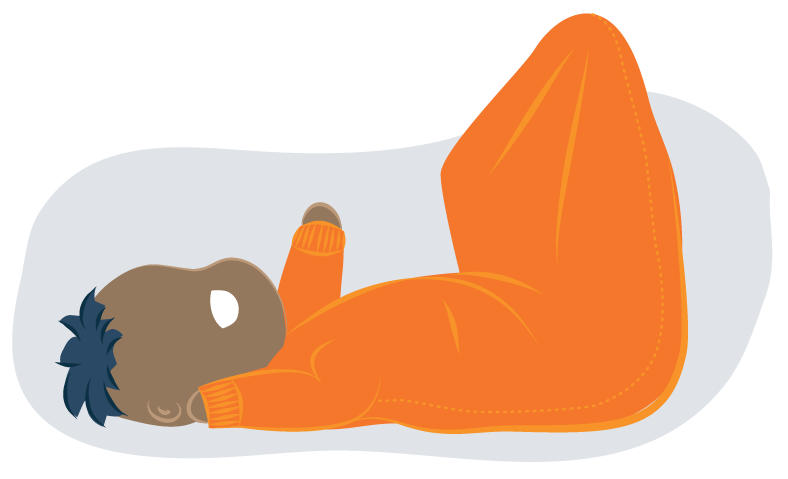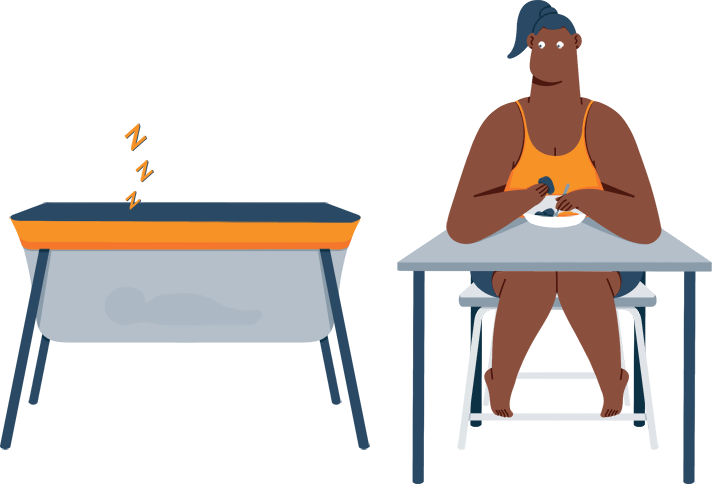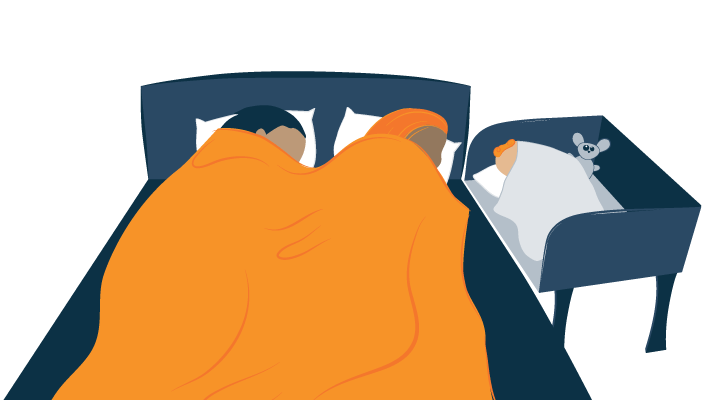Portable cribs can be a parent’s best friend. You can use them for naps around the house, take them with you on visits to Grandma’s house, or even use them for room sharing with your little one. Most parents agree that this is a must-have item on every baby registry, but a common question is, “How long can my baby sleep in a pack ‘n play?”
Do you ever feel like parenting should come with an instruction manual? If you do, you’re not the only one, which is why we’ve gathered all the essential information you need to know about using a folding crib for your baby. Keep reading to learn about what a pack ‘n play is and the best way to utilize this sleep accessory.
*“Pack ‘n play” is a registered trademark of Graco Children’s Inc. However, unless specifically noted otherwise, this article uses the term to refer to the modern type of playpen that is designed to be easily transported.”
What is a Pack ‘n Play?
New parents quickly realize that babies come with a lot of stuff. That’s why multifunctional items like pack ‘n plays are so essential for saving space and sanity. Pack ‘n plays can be used for sleep, play, and, in some cases, even for changing diapers!
These portable, folding devices have solid and sturdy perimeters with mesh sides that are breathable and allow for easy viewing. Some have attachable bassinets for those early newborn days and/or changing stations for an all-in-one functional item. This makes these playards great for travel, day trips, or just to use around the house.
Which Position is Best for the Baby to Sleep In?
According to the American Academy of Pediatrics1 (AAP), infants should always be placed on their backs to sleep to reduce the risk of sudden infant death syndrome (SIDS). According to the AAP, “3,000 babies in the U.S. die of sudden infant death syndrome (SIDS) and other causes that are unclear at first, including accidental suffocation or strangulation1.”
At one time, physicians recommended babies sleep on their stomachs or sides to improve conditions like reflux, but the back is now considered the safest sleeping position, even for babies with reflux2.
While we aren’t entirely sure why back sleeping is safest, scientists believe that sleeping on the stomach or side may lead to obstruction of oxygen and more difficulty waking up if they stop breathing2.
Around six months of age, many infants start rolling over and may end up sleeping on their stomachs or sides. If your baby is rolling, continue to place them on their back to sleep at night and for naps, but if they roll over in her sleep, don’t worry about repositioning. We suggest moving your baby from a swaddle to a sleep sack3 once they can roll over. This way, if they get stuck on their stomach, their arms will be free to help them roll onto their back.
Pack ‘n Play Key Considerations
Playards are multi-functional and can make your life as a parent so much easier. Like every other baby item, they do come with some risks. It’s important to familiarize yourself with some key pack ‘n play considerations for your little one’s safety and your own peace of mind.
What is the Standard Size of a Pack ‘n Play?
The size of your pack ‘n play will depend on whether you purchase from the Graco site or purchase a playard from a different brand. According to the U.S. Consumer Product Safety Commission4 (CPSC), a typical size for a playard is between 49.75 and 55 inches for the length and no wider than roughly 30 inches.
How to Know If Your Baby Has Grown Out of Their Pack ‘n Play
Similar to a crib, if your baby is standing in their pack ‘n play, they’re likely ready to transition to a toddler bed. Pushing on the edges of the playard can be dangerous, so if you see your baby exhibiting behavior like this, it might be time for a toddler bed.
Likewise, if your child tries to climb out of their playard, they’re in danger of getting hurt, so it’s best to move them to a bed that doesn’t pose the risk of climbing over the edge and falling.
Lastly, if your toddler simply expresses to you that they dislike their pack ‘n play, whether it be verbally or physically (visible signs of frustration), they’re likely able to sleep in a real bed or play without a constricting playpen keeping them contained.
Pack ‘n Play Height and Weight Limits
The best place to turn to for trustworthy answers regarding height and weight limits is the manufacturer of the item you’ve purchased (or are considering). Each company has its own recommended weight and height limits, and these suggestions can vary from product to product.
For the most part, playards are intended for children who are at most 35 inches tall and weigh less than 30 pounds, according to Consumer Reports5. However, still check with the manufacturer.
Safety Guidelines About When to Stop Using a Pack ‘n Play
Do Loose Pack ‘n Play Ends Pose a Risk?
If you’re using an older pack ‘n play model or one that has been damaged over time, be sure to check the U.S. Consumer Product Safety Commission’s website for any safety warnings or recalls. Damaged items can pose a risk for babies in multiple ways; loose ends can snag buttons or snaps on pajamas, and any sharp or protruding edges could cause harm.
Another safety concern related to the pieces of a play yard is strangulation. If there are any loose parts, discontinue use and contact the manufacturer immediately. Also, always be sure to place the pack ‘n play far away from hanging cords, drapery, or windows6. This way, your baby won’t be able to pull on anything and harm themself.
How Can I Prevent My Baby From Being Trapped or Injured in a Playard?
Updated safety standards7 for playards were implemented in 2013. Some of the changes that were implemented to prevent injuries and entrapment include side rails that don’t form sharp V’s when folding, stronger corner brackets, and sturdier mattress attachments to the playard floor. Buying a safety-approved model and following the proper usage guidelines are the best ways to keep your baby safe.
Is it Safe for Infants to Sleep in a Playard All Night Long?
If you’re looking for a place for your baby to sleep at night, “a crib, bassinet, portable crib, or playard that meets the safety standards of the Consumer Product Safety Commission (CPSC) is recommended”, according to the American Academy of Pediatrics8.
Make sure you continually check the safety of your baby’s pack ‘n play, just as you would with a crib or bed. As long as the playard is approved for safety and your little one hasn’t outgrown it, sleeping in a pack ‘n play for longer periods like overnight shouldn’t be an issue.
Is Sleeping in an Attached Bassinet Safe?
In those early newborn days when you don’t want to let your child out of sight, using an attached bassinet can be a lifesaver, especially when it comes to those midnight feeds. These products allow parents to sleep next to their baby without the danger of actual co-sleeping. Many playards come with an attached bassinet that can be used at the parents’ bedside as well.
The most important considerations with these attachable items are to make sure that you follow the safety recommendations (such as properly securing to the playard), and that you stop using them once your infant has outgrown the maximum weight, which you’ll find in the product description.
Additional Safety Guidelines
- Are the sides stretched out or damaged? If so, your baby’s arms or legs could get stuck in a hole in the mesh, or stretched-out sides could make the pack ‘n play less stable.
- Is there a safe area to place the play yard? If there isn’t a flat, firm area where you can put your baby’s pack ‘n play, it could reduce the travel crib’s security and stability. Not only that but make sure cords and other items your baby could grab onto are far away from the play yard.
- Do the playard sheets fit properly? Just like with a crib mattress, you want to make sure your baby’s sheets fit tightly in the pack ‘n play, so there isn’t loose bedding that could strangle or suffocate your child.
- Is the pack ‘n play mattress in poor condition? If so, either purchase a new pack ‘n play or buy the exact same mattress as the original one. If you buy a mattress that doesn’t fit the pack ‘n play space perfectly, you risk your child getting their limbs or head stuck in between the playard and the mattress.
Should I Add Extra Bedding to a Pack ‘n Play?
According to the Mayo Clinic9, a baby’s crib should not include blankets, pillows, or toys. All of these items can be hazardous for babies and increase the risk of sudden infant death syndrome (SIDS). Once your child is over the age of one, we recommend introducing a light, breathable blanket since the risk of SIDS will have decreased dramatically by this point9.
Playards also don’t need any extra mattresses beyond what comes included. Adding a mattress could leave space where your baby can be entrapped. Babies should always sleep on firm surfaces, whether it’s in a crib, playard, or bassinet9.
If you’re worried about your little one becoming cold, you can consider using a safety-approved swaddle blanket or maybe a sleep sack. These wearable blankets can be worn over your baby’s onesie or pajamas to add an extra layer of warmth for cooler temperatures. Sleep sacks are recommended once your baby can roll over because this sleep accessory allows the arms to be free3.
Also, keep in mind that the ideal room temperature for a baby is between 65 and 72 degrees Fahrenheit to prevent overheating.
Playards as Diaper Changing Stations
New parents are often surprised by how much time their child spends sleeping and eating. Having a diaper changing station attached to where your baby sleeps and plays can make life a whole lot easier. Many pack ‘n play models even come with built-in storage for items like diapers and wipes.
If you choose to purchase a play yard with an all-in-one design, just be sure to familiarize yourself with the recommended safety guidelines. For example, never leave your baby unattended on the changing table, and discontinue use of the product once your baby reaches the maximum weight and height.
FAQs
Is it safe for a baby to sleep in a Pack ‘n Play every night?
Yes, it is safe for a baby to sleep in a pack ‘n play every night, according to the AAP9. Of course, make sure you’re following the safety guidelines for the playard you purchase and ensure that the product itself is up to CPSC standards.
When should I lower my Pack ‘n Play mattress?
The Graco website10 says infants that weigh up to 15 pounds can sleep in the bassinet portion of the pack ‘n play, but once your baby weighs more than that, you should lower the mattress to the bottom of the pack ‘n play10.
Is a Pack ‘n Play mattress the same size as a crib mattress?
No, a pack ‘n play mattress is not the same size as a crib mattress because pack ‘n plays are typically smaller than cribs. Therefore, do not try to substitute one of these mattresses for the other.
Conclusion
For many new parents, a pack ‘n play is a functional item that can be used for sleep, play, and even changing diapers. Being portable means they’re also perfect for small spaces and families on the go.
Whether your baby is using their pack ‘n play for the occasional nap or for room-sharing at night, they should be safe and secure as long as you follow the recommended guidelines on weight, height, and use.
References:
- Falusi MD, Lanre O. “Sudden Infant Death Syndrome (SIDS): Common Questions & Concerns”. American Academy of Pediatrics HealthyChildren.Org. Last modified September 29, 2022. https://www.healthychildren.org/English/ages-stages/baby/sleep/Pages/Sleep-Position-Why-Back-is-Best.aspx.
- Porto MD, Anthony. “What is the safest sleep solution for my baby with reflux?”. American Academy of Pediatrics HealthyChildren.Org. Last modified November 30, 2021. https://www.healthychildren.org/English/tips-tools/ask-the-pediatrician/Pages/What-is-the-safest-sleep-solution-for-my-baby-with-reflux.aspx#:~:text=Back%20sleeping%20is%20the%20best,even%20for%20babies%20with%20reflux.
- “Are Sleep Sacks Safe for Babies?”. Cleveland Clinic. https://health.clevelandclinic.org/sleep-sack-safety/. 2022.
- “Play Yards Business Guidance & Small Entity Compliance Guide”. United States Consumer Product Safety Commission. Webpage accessed July 26, 2024. https://www.cpsc.gov/Business–Manufacturing/Business-Education/Business-Guidance/Play-Yards.
- “Play Yard Buying Guide”. Consumer Reports. Last modified May 13, 2016. https://www.consumerreports.org/babies-kids/play-yards/buying-guide/.
- Cronan, Kate M. “Crib Safety”. Nemours Kids Health. Last modified February 2019. https://kidshealth.org/en/parents/safety-crib.html#:~:text=Also%20check%20that%3A,or%20within%20the%20baby%27s%20reach.
- “Keep Baby Safe in Play Yard Space”. United States Consumer Product Safety Commission. Webpage accessed July 26, 2024. https://www.cpsc.gov/s3fs-public/playyard.pdf.
- “American Academy of Pediatrics (AAP) Recommendations”. Sleep Safe Missouri. Webpage accessed July 26, 2024. https://safesleep.mo.gov/american-academy-of-pediatrics-recommendations/#:~:text=Use%20a%20firm%20sleep%20surface.,crib%20except%20for%20the%20baby.
- “Sudden infant death syndrome (SIDS)”. Mayo Clinic. July 19, 2024. https://www.mayoclinic.org/diseases-conditions/sudden-infant-death-syndrome/symptoms-causes/syc-20352800.
- “Pack ‘n Play® On the Go™ Playard with Folding Bassinet”. Graco. Webpage accessed July 26, 2024. https://www.gracobaby.com/home-and-gear/pack-n-play-playards/classic-pack-n-play-playards/pack-n-play-on-the-go-playard-with-folding-bassinet/SAP_2120159.html?bvrrp=Main_Site-en_US%2Freviews%2Fproduct%2F2%2FSP_92300.htm&actionPoint=Show&pid=SAP_2120159.

Emma Cronan
Writer
About Author
Emma is an Editorial Intern for Sleep Advisor. She collaborates with the editor and staff writers to come up with article ideas, create article outlines, and write for the website.
Combination Sleeper



